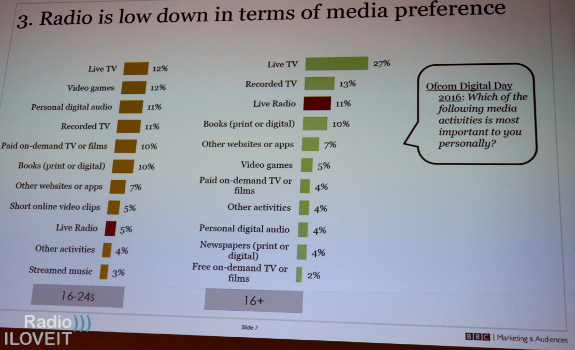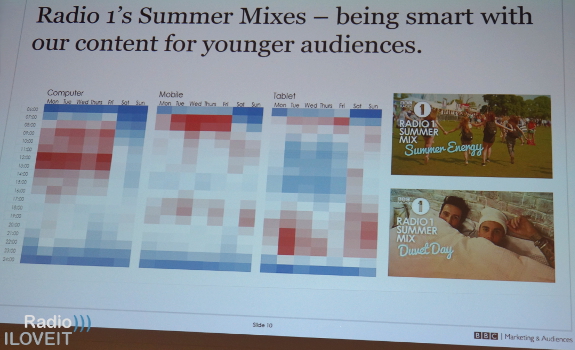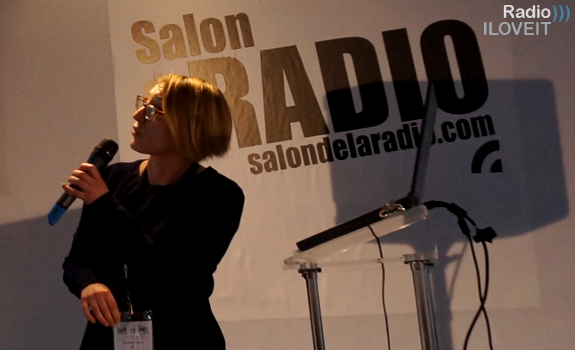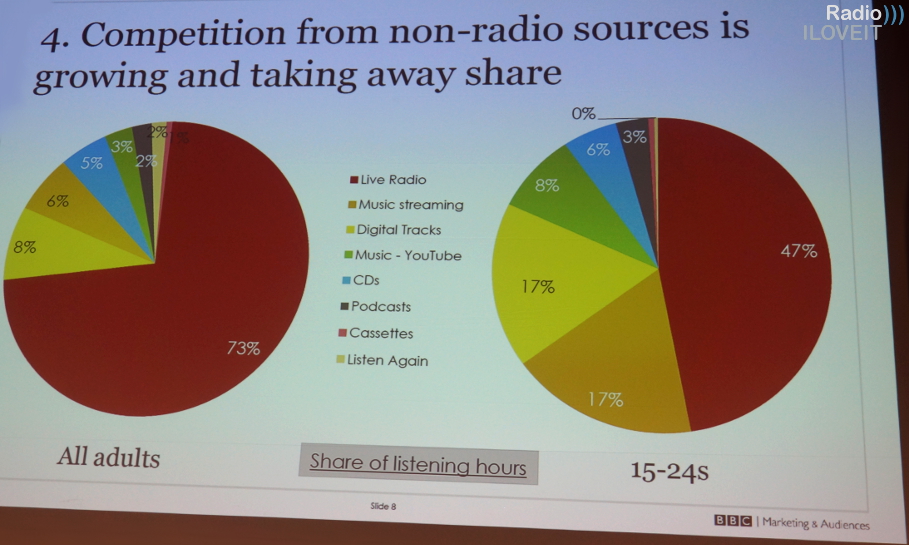BBC Radio 1 audience researchers are not only finding out what millennial radio listeners desire, but also on which device and at which time they want it delivered.
Following part 1 of this article, focused on American millennials, we now look at what research from the UK can teach us regarding how to reach 15-24 year-olds with radio (and its brand extensions on other platforms). The BBC presentation during Le Salon de Radio 2017 in Paris shows that, while there are challenges for radio, there are also opportunities to attract the millennial generation to radio.
‘Unexpected is that several forms of TV, as well as books, still seem to be so highly ranked’

Millennials seem to talk more about games and videos than TV and books (image: Thomas Giger)
Check your power rotations
Elisabeth Lane from the BBC’s Marketing & Audiences research department opens with a positive note. RAJAR ratings from Q3 / 2016 prove that young people in the UK are still listening to radio quite often. Almost 83% of 15-24 year-olds are listening to broadcast radio every week. In terms of nationwide stations, the biggest youth brands in the country are BBC Radio 1 with a reach of 2.97 million 15-24s (a 37% share of this audience group), closely followed by Global Radio’s Capital (2.90 million or 36%), and on a distance by Bauer Media’s KISS (1.73 million or 22%).
Millennials are still finding radio, they’re just listening less. Over the course of 10 years, the average time spent listening to UK radio per week among millennials between the age of 15 and 24 has dropped: from 19.9 hours (Q3/2006) to 14.7 hours (Q3/2016). That’s -5.2 hours a week (a 26% decrease). It can be good for radio stations targeting young listeners to ensure that their power rotations, especially for current hits, still fit the average time spent listening. In this case: 14.7 hours / 7 days = 2.1 hours a day, keeping in mind that these 126 minutes probably consist of multiple shorter listening occasions during the day, and that the average weekday TSL may be longer than the average weekend day TSL).
Use your in-car leverage
Similar to findings in the US (see part 1), UK millennials are spending less and less time with radio at home, because there’s more and more competition from other media. The index of total weekly listening among 15-24 year-olds shows that over the same 10-year period between Q3/2006 and Q3/2016, at-home listening has dropped with almost 3 quarter hours a week (-43 minutes, a 52% decrease). The good news, just like in the US, is that UK millennials also still listen a lot in the car, where broadcast radio has less competition for now. In-car listening has been nicely growing (+26 minutes, a 34% increase) during these 10 years, which compensates for a decrease of listening at work and other locations (-28 minutes, a 9% decrease).
A great benefit of radio is that you can listen while doing something else. You cannot watch videos, or read & send messages, when sitting behind the wheel (when you want to drive safely). The fact that there are not many connected cars (which 15-24s can easily afford) yet opens a window to market your brand towards in-car listeners, strengthening radio’s position as first in-car medium (and getting your station on a strategic preset) through a combination of great content & marketing before streaming services can get full access to car stereos, which seems to be a matter of time. We’ll share promotion ideas for in-car listening in an upcoming Premium Member article. Give it a try for 7 days!
Make your brand matter
Marketing radio and your station as in-car favourite may help you to stay relevant for millennials. Media regulator Ofcom has asked UK consumers in 2016 which medium activities are most important to them personally. Using the deck creator page on their research site, we see that live radio was mentioned by 11% of 16+ (a group including many middle-aged and older people) as their medium of highest personal importance, while live radio’s position among the younger end of the millennials (16-24) is considerably lower with 5%.
What I find interesting, is that radio listening seems to be equally important to millennials than online videos (also 5%), while I see around me that young people are watching a lot of them, and that streamed music is ranked lower (only 3%) in terms of what 16-24 year-olds consider to be the most important medium. Also unexpected is that several forms of TV (which many millennials that I speak with consider to be outdated), as well as books, still seem to be so highly ranked, on a level that is equal or close to the weight assigned to video games (something that I hear 16-24s talk about a lot). I hardly ever hear them talk about broadcast TV, seeing them engaged with online videos on their smartphone instead.
‘Know when your audience prefers which device to access which content’

This allows you to offer the right content to the right device at the right time (image: Thomas Giger)
‘Mobilise’ your websites & apps
Going back to the BBC study, it’s evident that in terms of listening hours, millennials are consuming less broadcast radio, and more other audio. Live radio still has a wonderful 73% listening time share among all adults, but ‘only’ 47% among 15-24s. Millennials are devoting quite some time to music streaming and digital tracks (both 17%), followed by YouTube songs (8%) and, surprisingly, CD tracks (6%). Looking at the share of listening hours by device: well, Bob Dylan was right. The Times They Are a-Changin’ — and they’re doing it fast.
All adults are spending 62% of their listening time with FM/DAB radio, followed by smartphones and laptops (both 11%), and on smaller scale by CD & MP3 players and tablets. 15-24s are spending ‘only’ 36% of their listening time with FM/DAB radio, which is caused by the much higher popularity of laptops and smartphones (both 23%) in this age group, as well as a slightly higher use of CD & MP3 players and tablets. Interesting is that tablets are way behind in total listening time (2% among all adults, 3% among 15-24 year-olds) compared to laptops. But in any case, you want to have a great online & mobile presence for your brand, making your websites and apps both millennial appealing and mobile responsive.
Map your audience behaviour
The BBC is taking audience research to another level. They find out during which days & times the audience is using which devices to consume which content. The public broadcaster’s research department did this for the BBC Radio 1 target audience demographic (millennials 15-29) in relation to traffic data for the station website. The above heat map shows hot versus cold (red versus blue) zones for website traffic from computers, mobiles and tablets in a matrix for certain days and times. Young audiences in the UK clearly start their day browsing on their mobile phone, especially between 7 and 9am. Except for Monday morning. Are they less in the mood for it then?
It looks like computers take over from 9am (when many are arriving at school or work) until 4pm, with a peak between noon and 2pm (when most are having lunch). The low computer usage on Thursday is puzzling, by the way. Was this a holiday, which may have affected the usual traffic to the BBC Radio 1 site? As many people also have a PC or Mac at home, it’s interesting to see that home computers seem insignificant during evenings and weekends.
Push your content accordingly
From about 4pm (when most schools are out, and many employees go home), millennials seem to gravitate back to their phone until around 8pm (when most have arrived at home), even if they apparently use it less to surf online than in the morning. Their cell phone pattern reflects a different lifestyle during weekends (when people might be getting up later). Based on this case, 15-24s seem to use tablets mainly at home, looking at the light red color during weekday mornings between 7 and 9am, and again after they’ve got home (especially after the evening peak time of smartphones, which ends around 8pm).
Interesting is the heavy red color indicating intensive tablet usage on Tuesday evening, compared to other evenings. Tablets seem to be used mostly during weekends — even more than smartphones, and for sure more than computers. Once you know which content your target audience prefers to receive on which device and when, you can push the right content to the right device at the right time for your listener demographic. Using insights from the traffic heat map, BBC Radio 1’s Summer Mixes 2016 were deliberately promoted during weekday mornings, when young people want to (find the right music to) get into the mood for the day. They could download episodes to the mobile BBC iPlayer app.
“Make it easy to access content digitally”

Elisabeth Lane talks about the impact of several online platforms connected (image: Thomas Giger)
Start your experiments today
There’s more good news for radio. On the long term, it pays off to invest in new formats, like podcasts. That kind of downloadable audio content seems to be small with a 3% share of total listening time among 15-24 year-olds, which is hardly more than the 2% share of that among all adults, but there is an upward trend going on for several years. Between Q1/2008 and Q3/2016, the podcast reach in the UK has increased from over 2 to almost 5 million listeners a week (which equals to 375.000 more weekly listeners every year).
The average age of podcast listeners in the country is 36 years; much younger than the average age of radio audiences. And while just 14% of all radio listeners in the UK is under 25, already 23% of all podcast listeners there is under 25. So it looks like millennials dig it. “We see this as a great opportunity for us in the BBC, making great speech audio as a way to attract a young audience”, Elisabeth Lane says. Indeed, it could be worthwhile to produce special content for station-related (and sponsor-related) podcasts. Over the course of a couple of years, they might grow into new audience & income streams, which you can run in addition to your on-air output.
Reinforce your platforms collectively
The strategy of BBC Radio 1 is multi-platform oriented, with a goal to drive traffic from one platform to another, like from YouTube to the homepage to the iPlayer through cross-promotion. While they’re connected to the main brand, different platforms have different functions. YouTube is used for showing live performances; the website for streaming (on-demand) radio; the iPlayer for streaming (long-form) documentaries. According to Lane, their channels have “really good numbers”. She mentions 8 million views a month for BBC Radio 1’s YouTube channel, and 2 million visits per week for its website (December 2016). “As soon as you make it easy to access content digitally, you can see great success.”
Header image: Thomas Giger






Add Your Comment